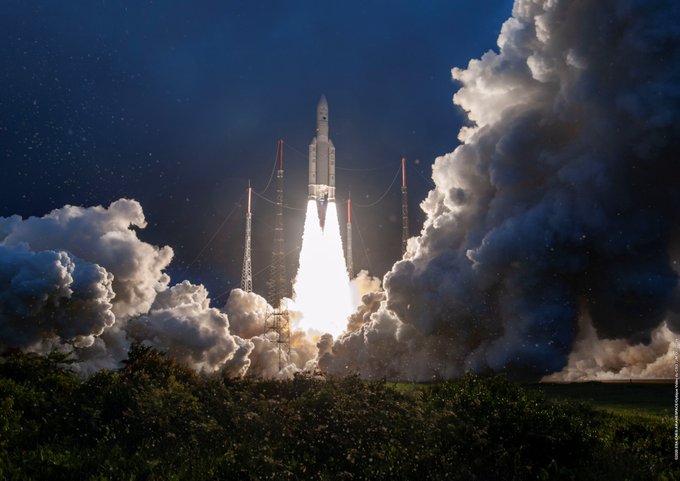New Delhi (NVI): India’s latest ‘high power’ communication satellite GSAT-30, aimed at providing high-quality television, telecommunications and broadcasting services, was successfully launched from the Spaceport in French Guiana, in South America, in the early hours today.
The Indian Space Research Organisation (ISRO) said the ‘flawless flight’ lasted about 38 minutes.
The European space consortium Arianespace’s Ariane 5 vehicle injected GSAT-30 into the orbit.
The 3,357 kg satellite, which was deployed from the lower passenger position of Ariane-5 launch vehicle (VA 251) into to geostationary transfer orbit (GTO), is configured on ISRO’s enhanced I-3K Bus structure to provide communication services from Geostationary orbit in C and Ku bands.
GSAT-30 is to serve as replacement to the “aging” INSAT-4A spacecraft services with enhanced coverage, ISRO has said, adding the satellite provides Indian mainland and islands coverage in Ku band and extended coverage in C-band covering Gulf countries, a large number of Asian countries and Australia.
India's communication satellite #GSAT30 was successfully launched into a Geosynchronous Transfer Orbit by #Ariane5 #VA251.
Thanks for your support !!!
For details please visit: https://t.co/FveT3dGuo6
Image Courtesy: Arianespace pic.twitter.com/67csn0zZq7
— ISRO (@isro) January 16, 2020
With a mission life of 15 years, GSAT-30 is an operational communication satellite for DTH, television plink and VSAT services.
“GSAT-30 has a unique configuration of providing flexible frequency segments and flexible coverage. The satellite will provide communication services to Indian mainland and islands through Ku-band and wide coverage covering Gulf countries, a large number of Asian countries and Australia through C-band,” ISRO Chairman K Sivan said.
P Kunhikrishnan, ISRO’s U R Rao Satellite Centre Director, who was present in Kourou, congratulated the ISRO community and Arianespace team on the successful launch.
Calling it an “excellent start” to 2020 for ISRO with the launch, he said, “The mission team at the master control facility have already acquired the satellite and they will immediately complete the post launch operations.”
Eminent politicians like Lok Sabha member Mahesh Sharma, and Vice President Venkaiah Naidu congratulated the success of the launch via twitter.
Congratulations to ISRO for
the successful launch of India’s latest telecommunication satellite #GSAT30 into a Geosynchronous Transfer Orbit (GTO) from Kourou launch base, French Guiana. @isro— Vice President of India (@VPSecretariat) January 17, 2020
My heartiest congratulations to the team @isro for the successful launch of high power communication satellite #GSAT30 into Geosynchronous Transfer Orbit. Another day & another phenomenal accomplishment by our scientists. It is a proud moment for the entire nation.
Jai Hind ?? pic.twitter.com/fE7ISlPPwx— Dr. Mahesh Sharma (@dr_maheshsharma) January 17, 2020
ISRO’s Master Control Facility (MCF) at Hassan in Karnataka took over the command and control of GSAT-30 immediately after its separation from the launch vehicle. Preliminary health checks of the satellite revealed its normal health.
In the days ahead, orbit-raising manoeuvres will be performed to place the satellite in Geostationary Orbit (36,000 km above the equator) by using its onboard propulsion system. During the final stages of its orbit raising operations, the two solar arrays and the antenna reflectors of GSAT-30 will be deployed.
Following this, the satellite will be put in its final orbital configuration. The satellite will be operational after the successful completion of all in-orbit tests.








